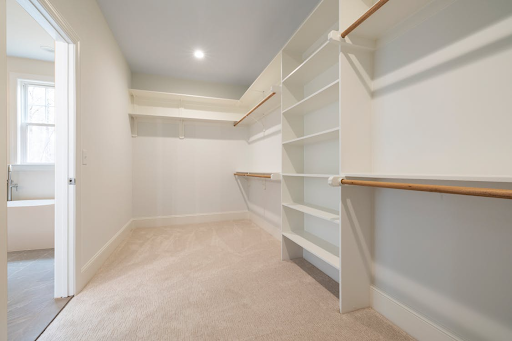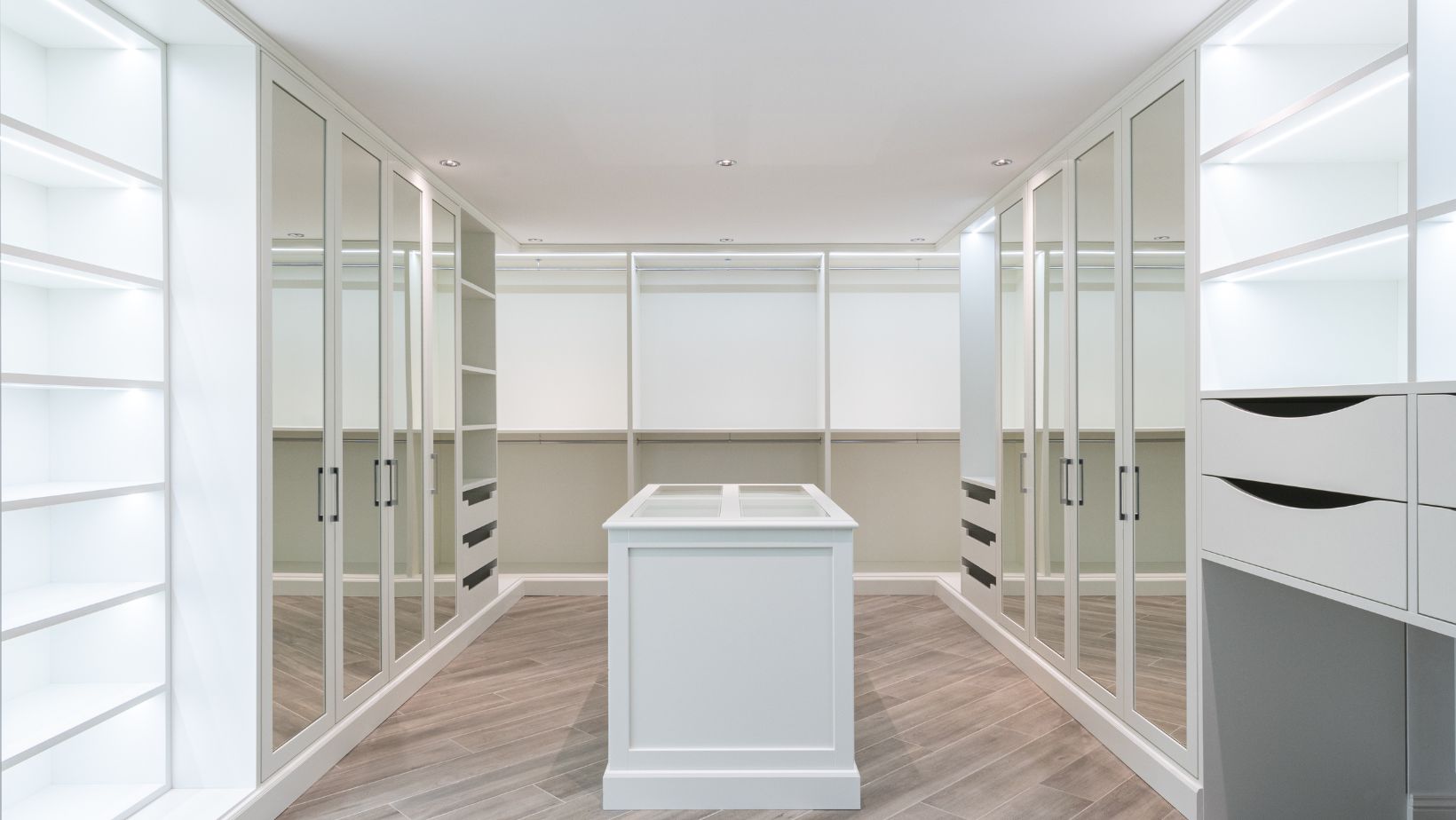Want to transform your bedroom into something spectacular?
Here’s the thing most people don’t realize…
Your closet design can make or break your entire space. And I’m not talking about just shoving some shelves in there and calling it a day.
The truth is: Your closet needs to work WITH your current space, not against it.
What you’ll discover:
- Why Your Closet Design Actually Matters
- The Space Planning Secret Nobody Talks About
- Custom Closet Solutions That Actually Work
- Match Your Style Without Breaking the Bank
Why Your Closet Design Actually Matters
Most homeowners think closets are just storage spaces. But here’s what they’re missing…
97% of realtors believe homeowners value closet space more than basement or attic storage. That’s not a coincidence.
Your closet is where you start and end every single day. When it’s designed wrong, it throws off your entire routine. When it’s designed right? It becomes the foundation of a perfectly organized life.
But here’s the kicker…
Most people approach closet design completely backwards. They focus on cramming as much storage as possible into the smallest space. What they should be doing is creating custom closet solutions that complement their existing interior design.
Companies like ClosetNow New York closets understand this concept perfectly. They don’t just build storage — they create systems that enhance your entire living space while maximizing functionality.
Here’s why this matters:
Your closet design affects your daily mood, productivity, and even how much you enjoy your bedroom. Get it wrong, and you’ll feel frustrated every morning. Get it right, and you’ll wonder how you lived without it.
The Space Planning Secret Nobody Talks About
Want to know something that’ll blow your mind?
Generally around 80 percent of available home area gets allocated to living space, 10 percent for passage, and 10 percent for storage.
That means your closet falls into that crucial 10% storage category. And if you’re not maximizing it properly, you’re wasting valuable real estate in your home.
But most people get this completely wrong…
They think bigger is always better. The reality? Smart design beats square footage every single time.
Here’s what actually works:
Start by analyzing your current space. Look at your bedroom’s flow, natural lighting, and existing color scheme. Your closet shouldn’t fight these elements — it should enhance them.
If your bedroom has modern, clean lines, your closet should follow that aesthetic. Got a traditional space with warm woods and classic details? Your storage solutions should complement that style.
The secret isn’t building more storage. It’s building the right storage in the right places.
Custom Closet Solutions That Actually Work
Here’s something most people don’t understand…
Custom doesn’t automatically mean expensive. What it means is thoughtful.
The greatest closet designs focus on three core elements:
- Functionality — Does it make your life easier?
- Aesthetics — Does it enhance your space?
- Flexibility — Can it adapt as your needs change?
Let’s talk about what’s actually trending right now…
31% of industry professionals list accent lighting as the top requested closet upgrade for 2025. That’s because proper lighting transforms a storage space into a luxury experience.
But lighting is just the beginning.
Smart closet solutions include:
- Adjustable shelving systems that grow with your wardrobe
- Built-in seating areas for getting dressed comfortably
- Display areas for shoes, accessories, and special items
- Mixed materials combining wood, glass, and metal for visual interest
The key is choosing elements that match your existing interior design while solving your specific storage challenges.
Matching Your Style Without Breaking the Bank
Here’s where most people mess up…
They think style matching means everything has to be identical. Wrong.
What you actually want is harmony, not duplication.
If your bedroom features contemporary furniture with clean lines, your closet can complement that with similar proportions and finishes. But it doesn’t need to be an exact replica.
Here are the elements that matter most:
- Color palette — Keep it consistent with your bedroom’s main colors
- Hardware finishes — Match or complement existing drawer pulls and fixtures
- Material textures — Echo the wood tones or metal accents in your space
- Overall proportions — Maintain the same visual weight as your other furniture
The good part? These design principles work whether you’re investing in high-end custom solutions or working with budget-friendly options.
But here’s the thing…
Don’t sacrifice functionality for aesthetics. The most beautiful closet in the world is useless if it doesn’t actually organize your stuff properly.
Smart Technology Integration
Want to know what’s revolutionizing closet design right now?
Technology integration. And I’m not talking about gimmicky gadgets.
75% of professionals are expected to use AI in closet design by 2025, up from just 25% in 2024. This isn’t just a trend — it’s the future of smart storage.
Smart features that actually make sense:
- Motion sensor lighting that activates when you enter
- Climate control systems that protect delicate fabrics
- Digital inventory tracking so you know exactly what you own
- Automated clothing organization that suggests outfit combinations
These aren’t luxury extras anymore. They’re becoming standard features in well-designed storage systems.
The Natural Light Factor
Here’s something most people completely overlook…
Natural light changes everything in closet design.
If your closet has access to natural light from your bedroom, you can use lighter colors and reflective surfaces to amplify that brightness. No natural light? You’ll need to compensate with strategic artificial lighting and potentially lighter color schemes.
The rule is simple: Work with your space’s existing light conditions, don’t fight them.
Sustainable Design Choices
Here’s what’s interesting about current design trends…
Sustainability isn’t just trendy — it’s practical. Natural materials like reclaimed wood and bamboo are becoming popular because they’re durable, beautiful, and environmentally responsible.
These materials also happen to work incredibly well with most interior design styles. They add warmth and texture without overwhelming the space.
Planning Your Closet Transformation
Ready to transform your closet space?
Here’s your action plan:
- Assess your current space — What works? What doesn’t?
- Identify your style preferences — How should it complement your bedroom?
- List your functional needs — What storage challenges need solving?
- Set a realistic budget — Custom solutions exist at every price point
- Research quality providers — Find companies that understand design integration
The biggest mistake you can make is rushing this process. Take time to plan properly, and you’ll end up with a closet that enhances your entire living space.
Wrapping This Up
Your closet design isn’t separate from your interior design — it’s part of it.
When you approach closet organization as an extension of your bedroom’s aesthetic and functionality, everything changes. You’re not just creating storage anymore. You’re creating a seamless living experience that makes every day better.
The greatest closet designs solve practical problems while enhancing the overall beauty of your space. They use smart technology, sustainable materials, and thoughtful planning to create something that’s both functional and inspiring.
Remember: Your closet should work as hard as you do. But it should also look as good as the rest of your home.
Whether you’re planning a complete renovation or just looking to optimize your existing space, the principles remain the same. Match your style, maximize your functionality, and create something that makes you smile every time you get dressed.
That’s the difference between storage and design. And that’s why your closet deserves the same attention as every other room in your home.



More Stories
Choosing the Right Fixtures for Your Kitchen and Bathroom Makeover
8 Ways to Stand Out in Real Estate
Crafting Identity-Led Spaces That Are Always Business First